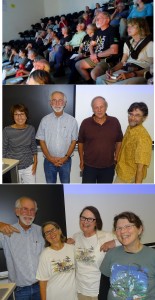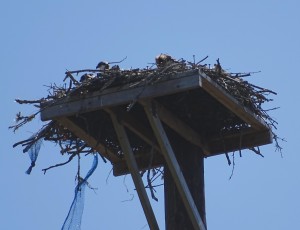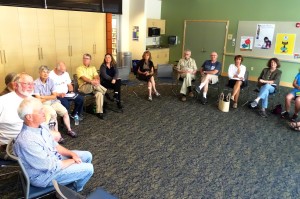These instructions are from Nathanael Swecker for access to his “patch” at JBLM and will work for other range areas as well:
Directions for getting Training Area Access pass for JBLM:
1) I went to the Main Gate of JBLM off of I-5 (exit 120).
2) I stopped and parked at the Visitor’s Center right before the gate itself and entered the office.
3) I pulled a numbered tab and sat in the waiting area for a clerk to call my number (just like in a DMV or DOL center).
4) My number was called and I approached the clerk’s window. I presented my Driver’s License, Proof of Insurance, Vehicle Registration. I stated that I would like to document bird populations on the Training Areas and that I needed access to the “Range Control” office.
5) The clerk didn’t ask me any probing questions or why I wanted to bird the areas. He simply made sure all my documents were valid and then told me to wait while he processed my request.
6) I sat back down in the waiting area and waited for him to call my name. This only took 5 min. He gave me a ONE DAY pass that I may only use to pass thru the gates and proceed to the Range Control office.
7) I left the Visitor’s Center and went south on I-5 to the next exit (exit 119) and went thru the Dupont Gate.
8) At the Dupont gate I used the far right lane to approach the guard station and presented my ONE DAY pass and my license. I stated that I was proceeding to the Range Control office. The guard waved me thru with no questions and I proceeded on Clark Road.
9) I went forward from the guard station thru the first intersection of Clark and West and proceeded to the next intersection and took a right on Kaufman Ave.
10) I passed the first building on the right and went on to the second building (bld 4074). I parked here and entered the building.
11) I approached the front desk and said that I would like to obtain a Range Pass for the purpose of “Wildlife Observation”. I presented only my Driver’s License and the quickly processed a pass for me on the spot.
12) They handed me my Vehicle pass that I must display on my dash and my wallet-pass that I must keep on my person at all times while on the Training areas. They gave me a pamphlet explaining the rules and regulations and sent me on my way! I was ready to explore the vast reaches of the JBLM Training Areas!
THINGS TO NOTE:
A. This pass will not get you thru any of the gated areas of JBLM. It only allows you access to the sanctioned Training areas that are ungated
B. You must only be on the Training Areas that are currently open. The website, http://www.lewis-mcchord.army.mil/DPTMS/training/range/docs/allocations.pdf , tells you which areas are open and closed.
C. You must call ahead and leave your info at (253) 967-6277. (this is just a recording number. You can’t actually talk to anyone, you just leave your permit number, time in, time out and activity to be performed)
D. Troops may be conducting activities on the open training areas. DO NOT BE ALARMED this is normal. The troops will not bother you and you do not need to ask them permission to be there. If an officer approaches you just explain what you are doing and they will let you know if you need to move or simply be aware of their presence. I run into troops all the time and they almost always ignore me.
E. Range Operations often drive the training areas in large pickup trucks with yellow license plates. They will stop you and engage you to make sure you are a permit holder. Their job is to make sure that the civilians are safe. Feel free to talk with them. They are not soldiers, they are contractors who monitor the training areas.
F. Military Police monitor the main paved roads. If they see you near any of the main paved roads they will stop and ask you for proper documents. I find it best to avoid them. Park in non visible places from the road.
G. Other civilians may be on the ranges as well. Sometimes I find groups of people horse back riding or walking their dogs. Sometimes I will travel all day for miles and not encounter a single person. There are sometimes biologists doing survey work as well.
H. There are wild animals on the training areas. There are bear, deer, elk, coyotes and more. Please be respectful around the wildlife.
This may appear to be a lot of info to gain access to the area, but if you do these things you will find it is really not that complicated.
Further notes from JBLM biologist, Denis DeSilvis:
Area access passes are only issued by Range Control personnel Monday through Friday up to 5 PM.
Item 4. You only need to mention that you need a vehicle pass in order to go to the Range Control office to get an area access pass. (The folks that issue the vehicle pass are checking to see if you are on any list of wanted criminals, terrorists, etc.) All passengers need to have a valid government-issued ID card to hand in at the same time as the driver/vehicle owner. Everyone will be listed on the pass.
Item 7. This is absolutely the best way to get to Range Control once you have the vehicle pass. All passengers need to hand over ID cards to the guard at the same time as the driver. (Driver should collect everyone’s cards beforehand and hand them over together with the vehicle pass.)
Item C. When you call into Range Control, you must include what training areas you’re going to visit, as well as the info Nathanael indicates.
Item F. Military Police (MP) drive both marked and unmarked vehicles. And they also check unpaved roads as well as paved ones. In some areas, civilian DOD police will be monitoring traffic.
When Training Areas are closed, don’t go there. Right now, because of budget constraints, all training areas are closed for recreation on Sundays and holidays.
If you see anything suspicious while out in the training areas, be sure to call the number that Range Control has on one of the handouts you’ll receive. This could be something like someone dumping trash, walking in an impact area, etc.
JBLM has some unique habitat in western Washington, with some unique birds for this side of the mountains.
And let me know if you find a White-breasted Nuthatch – I’ve been looking for one at JBLM for over 35 years.
May all your birds be identified,
Denis DeSilvis







